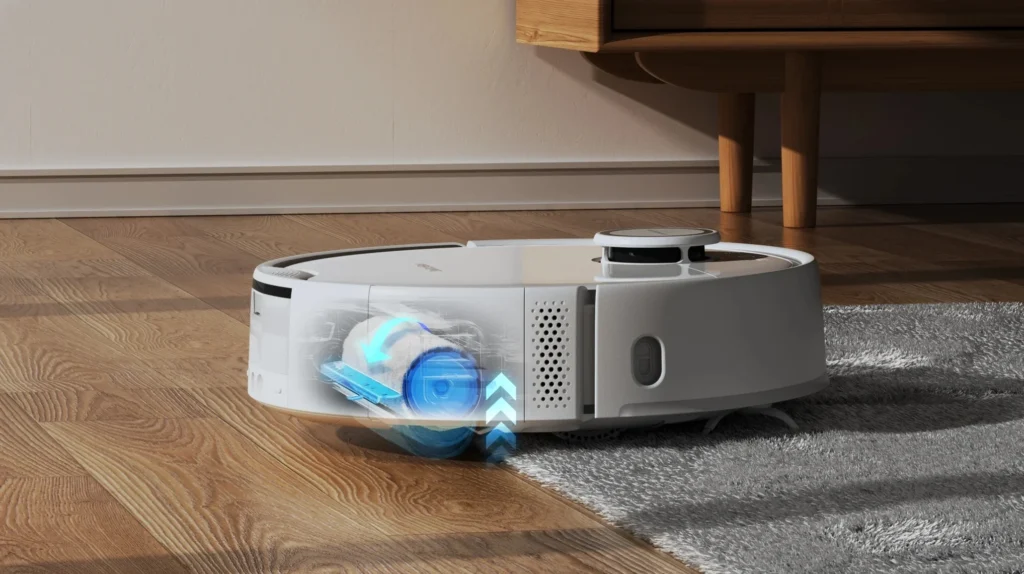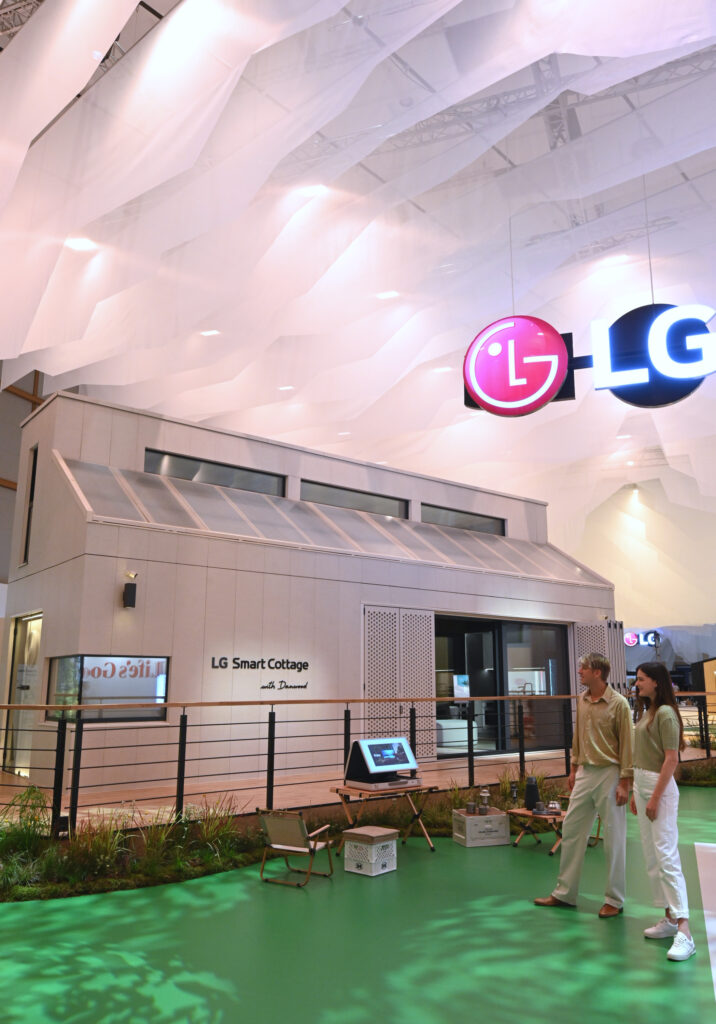IFA 2023: Next to the bathroom is the 2-in-1 washer and dryer; in the kitchen, the built-in oven and induction hob, a little further on the water purifier, while in another corner appears the Therma V air-water heat pump that cools and heats the room while reducing consumption and with a 200-litre tank in which it stores hot water. Passing through the door to the outside world, 4 kW solar panels can be seen on the roof, capable of producing up to 15 kW of electricity per day, with excess energy being stored in the Energy Store System for use in due course.
The Smart Cottage
The set of smart solutions winks at the environment and provides everything a home needs to run smoothly. LG’s Smart Cottage is the prefabricated house I visited at the Korean brand’s huge stand during the IFA in Berlin. It is a modular home structured on two floors, easy to transport to its intended location and built with technologies and products from a Korean company, which has chosen wood, brass and tiles for the interior decoration of the house.
Linked to ThinQ connectivity and managed with the app of the same name, it is also useful for adding security items such as surveillance cameras, motion sensors and smart doorbells; the Smart Cottage is an ideal representation of the home of the future. It is a good way of designing tomorrow, coveted by many and dreamt of by all sustainability advocates because the smart home was the trend that dominated the scene at Europe’s most important electronics fair.


Energy saving, according to Samsung and Haier
Even Samsung, which opened the waltz of presentations, focused the event on smart home solutions that combine comfort and sustainability, ensuring lower consumption and lighter bills. The other Korean giant’s solution is SmartThings, the application for managing small and large household appliances via smartphone, which, together with a series of useful functions for monitoring the activity of devices, allows their use to be optimised. Thanks to the extensive catalogue of homemade products and the system’s compatibility with the Matter standard, the hub integrates devices from 280 other companies with more than 285 million users. Rather than LG’s home spot, a desire that will remain so for 90% of the world’s population, Samsung is focusing on the effectiveness and simplicity of a system that helps us make better use of the products already in our homes.
IFA 2023
With functions such as SmartThings Energy, you learn how to optimise your relationship with your washing machine, fridge, oven and other household appliances according to your needs. Knowing in detail your monthly consumption and the resulting amount of your bill, you can take action to set a consumption threshold, which you can respect thanks to AI support and the energy-saving mode. This sets in motion a series of activities that go to the heart of the matter while keeping the energy effort in line. Thus, it happens that the washing machine can reduce consumption by up to 70% by using cold instead of lukewarm water for washing.


Close to such concepts is the approach of Haier, a Chinese giant that also controls the Candy and Hoover brands, with a comprehensive proposal for domestic spaces. In Berlin, it staged its usual huge stand, showing off first-class numbers: Yannick Fierling, CEO of Haier Europe, said the smart home brand is number 1 in Asia, number 2 in North America and Oceania, number 3 in South America and number 4 in Europe. The long list of new products connects to hOn, the app that continues to increase the number of products that can be managed via smartphones and are compatible with Alexa and Google Assistant.
Haier aims to make devices talk to each other to facilitate household tasks. One example is the contact between the refrigerator and the oven, with cameras and sensors built into the former able to recognise the food placed inside to communicate it to the oven to suggest which dishes to enjoy for dinner. This is not a science fiction scenario; it is not long before we get there because the biggest obstacle is the variable most uncontrollable by technology: the human being.
Useful robots for the home
More than other similar events, IFA is the fair of robots, which in recent years have abounded in the more than 25 halls of the Messe Berlin. Beyond acrobatic dogs and humanoids designed to give smiles and little else, there are always plenty of good products to improve the home. One of the most interesting seen this time was the Switchbot S10, which washes, sucks and flushes water autonomously. Small and compact, it is also ideal in a flat as it does not take up much space. But more importantly, when seen in action, it looks very effective, thanks to the roller for washing the floors and the 4-litre bag to contain the dirt, which should be changed on average every 70 days. The company has chosen to rely on Kickstarter to secure some sales: the price for the basic kit starts at $1,199.


Also to follow is Pure One Station, a wireless hoover by Tineco (a Chinese brand under the control of Ecovacs Robotics) that collects dirt in its 3-litre tank, a measure that the company claims allows it to be emptied every 60 days. For the suction of particles with a minimum diameter of 0.3 micrometres, the device uses a 5-layer Hepa H13 filter; in addition to the anti-tangle brush, the power adjustment sensor, the LED display showing useful information and the self-cleaning system that cleans the brushes and filter when the device returns to the charging station. Pure One Station weighs 2.4 kg and is on sale for €799. Not an absolute novelty, mind you, but an object that cleans the house for us. For this alone, it is a good starting point.
The quality of solutions on offer at IFA proves that having an intelligent and relaxing home is no longer an unattainable goal. The technologies and products are there, too, so it is up to the user to find the right fit to build the ideal home.



